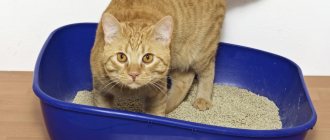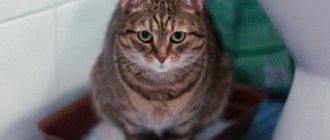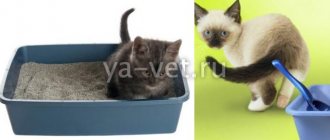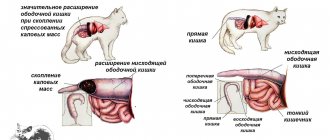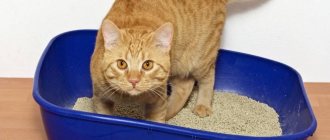- home
- Treatment
- Symptoms of cat diseases
- The cat rarely walks small
If the cat begins to go to the toilet a little, the owner should be wary and immediately take action and seek help from a specialist. Perhaps the problem appeared due to regular improper feeding of the pet, for example, you gave the cat only dry food without diversifying the diet, which has an extremely negative effect on digestion.
But in most cases, if a cat doesn’t go to the toilet a lot, this is a sign of illness. But a visit to the veterinary clinic will help you determine exactly which one, because without an examination it will not be possible to establish a diagnosis and prescribe treatment.
By contacting our veterinary center, you will receive qualified assistance from professionals with many years of experience who will conduct the necessary examinations and take tests. After diagnosis, depending on the disease and the cat’s health condition, the doctor will either prescribe medications or prescribe surgery.
How many times a day should a cat go to the litter box?
Kittens under 3 months of age usually go to the toilet very often. However, it is impossible to talk about any norms, since at this moment the organs are not yet developed, and therefore it is difficult for the animal to control the evacuation schedule. Kittens from 3 to 6 months are more independent. They visit the litter box about 6 times a day or more. During this period, a habit is developed.
Adults over 6 months defecate:
- 2-3 times a day for cats;
- 3-5 times a day for cats.
This difference is explained by the fact that the structure of the genitourinary tract in animals is slightly different. In cats, the urinary duct is narrower.
Some pets can visit the litter box once a day. If this is a standard schedule, then it should not cause concern to the owner. In very rare cases, pets go to the toilet once every 2 days and do not show signs of illness.
Where to go for help
You can call us at the veterinary office. We employ experienced specialists who are well versed in their field, and they will definitely help your pet. Our own laboratory allows us to obtain examination data within an hour, and modern equipment makes it possible to carry out complex emergency operations. With our surgeon, your cat is in good hands. Come, call or leave requests on the website - we won’t leave you in trouble!
POLAR BEAR
The veterinary clinic in Nizhny Novgorod "White Bear" provides all types of services for cats and dogs.
Conducts any examinations and tests in its own veterinary laboratory; the clinic operates a veterinary ambulance for animals and a 24-hour veterinarian is on call at home. Agreement on the processing of personal data
Public offer
SITE MENU
- About the clinic
- Price list for veterinary clinic services
- Treatment
- Services
- Price list for veterinary clinic services
- Vetapteka
- Contacts
- Site Map
CONTACTS
- Nizhny Novgorod st. Vyatskaya 7
- 8 (831) 437-25-27
- [email protected]
The cat rarely walks small
The daily norm for urinating an animal is about 120 ml. At home, it is difficult to track the exact amount of fluid excreted, so you need to pay attention to how your pet behaves when visiting the toilet. Usually, if a cat rarely goes to the toilet in a small way, he begins to meow during his attempts. The animal shows irritability, does not allow itself to be petted, and begins to leave puddles around the tray, even if it behaves cleanly in everyday life.
The reasons for this may be:
- lack of clean water;
- excess salty foods;
- excess fish or meat in the diet;
- stress;
- low mobility of the animal;
- changing the filler or tray;
- diseases.
Usually it is enough to normalize the food or return the previous filler. But not in the case of diseases. If the symptoms appear suddenly, the furry probably has cystitis or another inflammatory disease. And urgent hospitalization is required.
Treatment
If a cat does not walk for several days or does so rarely, then a large number of microorganisms multiply in his bladder. At first, the cat should be in a hospital so that stagnant urine can be professionally removed. Using injections, fluid is administered to the pet to eliminate dehydration. The veterinarian also prescribes antispasmodic drugs to help relieve pain and relax the urethra. Antibiotics and antibacterial agents are usually used to help relieve inflammation in the bladder. After treatment, the cat is discharged home, where all care falls on the owner.
Corrective diet
If a cat is susceptible to urolithiasis, then it needs a corrective diet. It is necessary that the food be rich in vitamins B6, A and glutamic acid. Food should not contain salt and minerals, namely:
- The cat should have a complete exclusion of salty foods.
- Raw fish and meat are prohibited.
- The consumption of all types of fish is excluded. Phosphorus, found in any type of fish, is deposited as an excess mineral in the bladder and leads to the formation of stones.
- Milk should not be consumed by a pet with urinary problems. The point is the increased magnesium content, which will lead to even worse urine flow.
- Pork is too fatty meat, it will lead to thickening of urine, which will further complicate its outflow from the bladder.
The cat should eat special dry food, balanced for animals with problems in the genitourinary system.
Risk categories
Problems with urination often occur in cats that have undergone castration as children. There are cases when urinary retention occurs in kittens, but according to statistics, adults most often suffer from this condition, especially in cats. If a newborn kitten has a problem with urine discharge, then the reason, as a rule, lies in congenital mechanical obstruction of the urinary tract.
The cat rarely walks in a big way
The main reason why a cat doesn't go to the toilet very often is stress. It is quite normal if after moving the animal does not defecate for 1-2 days. However, then everything should return to normal. Often cats, due to stress, begin to go to the toilet in large quantities in hidden places, so the litter box remains empty. So before you sound the alarm, you should thoroughly “search” the apartment.
Other causes of constipation in cats are more serious:
- foreign body in the intestine;
- hernia;
- tumor;
- inflammation, etc.
In case of constipation, owners can try to give their four-legged enema themselves. However, if general apathy and loss of appetite are added, it is recommended to go to the veterinary clinic for an x-ray and an accurate diagnosis.
Causes of acute urinary retention in cats
The process of urine formation in the body is the result of several interrelated processes. It is these processes that are responsible for the homeostasis of the animal’s body. The development of acute urinary retention leads to anxiety in the pet. The animal stays in its tray for a long time, trying to cope with the pressing sensations from the bladder, which is overfilled with urine. The cat has a constant urge to urinate without success, which results in severe stretching of the bladder walls.
The fluid that is not removed from the body begins to circulate throughout the body in the bloodstream along with all the toxic substances collected from tissue structures. Intoxication with one's own metabolic products leads to the eruption of gastric contents, dehydration, loss of appetite, increased weakness and failure of the kidney structures.
Acute urinary retention syndrome can develop completely suddenly or as a result of progressive urinary excretion disorders. Urinary retention is recorded in cats and kittens, regardless of age. But it is more often diagnosed in males due to anatomical features. In males, the urethra is longer and narrower, which contributes to rapid blockage of the duct.
The reasons for the development of acute urinary retention syndrome are various. Making a diagnosis and determining the underlying factor is possible only in a veterinary hospital based on laboratory and instrumental studies. The mechanism of penetration is determined by a number of the following factors:
- Blockage of the urethral canal as a result of mechanical damage. It occurs due to the accumulation in the lower part of the urinary system of crystalline salts, cellular structures, protein and mucus against the background of inflammation. The cause is also the development of a tumor process that gradually blocks the urethral canal.
- Bladder atony is a pathological process based on the ability of the bladder to contract correctly.
- Bladder rupture is a pathological process that occurs as a result of mechanical trauma or against the background of severe stretching of the walls of the bladder.
- Anuria – occurs as a result of pathological changes in the renal system (chronic and acute failure of renal structures). It provokes a cessation of urine production, which results in acute urinary retention syndrome in a cat.
The development of the pathological process occurs with a pronounced clinical picture. An attentive owner will immediately notice changes in the general condition of his pet. Characteristic symptoms of acute urinary retention are:
- frequent urge to urinate, but not at all productive;
- excretion of urine in small portions (a few drops), accompanied by the presence of bloody streaks and mucus in the excreted urine;
- a pronounced increase in the volume of the abdomen, accompanied by tension and pain;
- the animal adopting an unnatural posture during the urge to urinate;
- painful sensations, cat screams while going to the litter tray;
- constant attention to the perineal area (frequent licking).
With the development of the pathological process, the situation worsens and the clinical picture becomes more pronounced. The cat loses its appetite, looks depressed, and has nausea and vomiting of gastric contents. With the development of urinary retention syndrome against the background of a pathological state of the renal structures, signs of dehydration and exhaustion of the body, polydipsia, appear.
The appearance of the first characteristic signs of urinary retention in a pet is a signal to immediately contact a veterinary clinic for help. This will prevent increased accumulation of nitrogenous substances in the body, as well as avoid the development of kidney failure. Without adequate help, the cat dies within 2-3 days.
Why does a cat pee a little?
A cat should pee, if it is already a year old, about 2 times a day. If urination does not occur for several days or a very small amount of urine is found in the tray, this indicates a malfunction in the body.
© shutterstock
This phenomenon can be caused by the following factors:
- Kidney diseases of congenital or acquired type.
- Urolithiasis (the most common reason why a cat doesn’t pee a lot).
- Inflammatory processes in the urethra or bladder. They can be caused by hypothermia or infection.
- Weakening of the bladder walls (atony). The reason for this may be an injury, surgery, illness, or age-related changes in the cat’s body.
- Anuria. This condition is characterized by the absence of urine and poses a threat to the animal's life.
- Spinal cord damage due to spinal injuries.
- Benign or malignant tumors.
Only a veterinarian can determine the reason why a cat pees little.
Do I need to call the vet?
Your cat may check a couple of these boxes, but the disease can also happen to those who don't fit that mold. What symptoms may indicate the development of bladder obstruction?
Very often, your cat may feel a little uncomfortable for a few days and may not eat or drink as well as usual. You might just feel like they're a little off.
Although sometimes there may be no warning. They go from normal to emergency in the blink of an eye.
Symptoms
If you notice any of the following, contact your veterinarian immediately:
- frequent trips to the garbage tray
- spend more time squatting without producing urine
- urine with a red tint
- crying or screaming, especially when urinating (or trying)
- increased arousal and restlessness
- often licking their backside
- pain when lifting under the stomach
© shutterstock
As the disease progresses, your cat may begin to vomit, lose consciousness, go into a coma, and eventually die.

